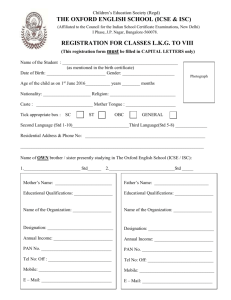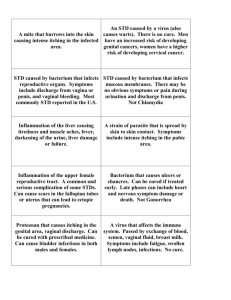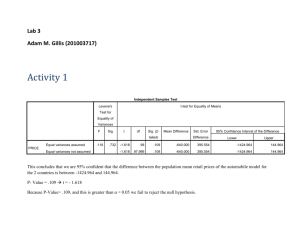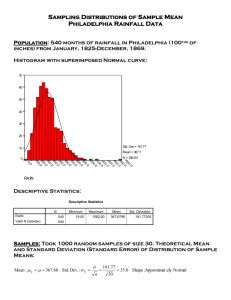DOC - David Hardoon
advertisement
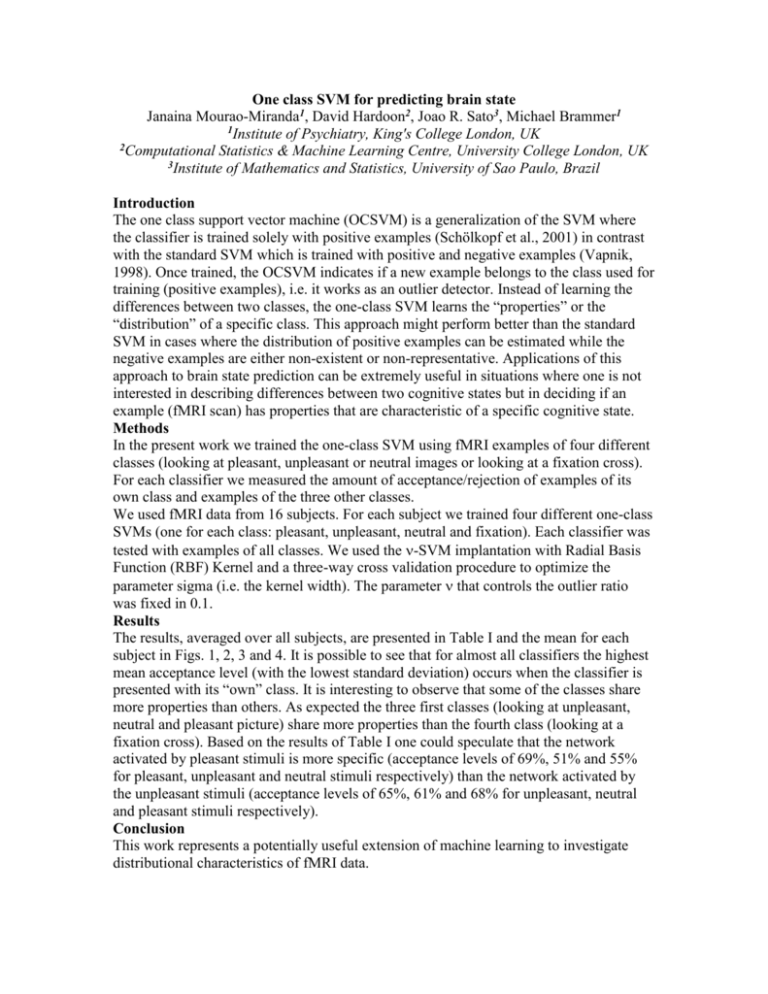
One class SVM for predicting brain state Janaina Mourao-Miranda1, David Hardoon2, Joao R. Sato3, Michael Brammer1 1Institute of Psychiatry, King's College London, UK 2Computational Statistics & Machine Learning Centre, University College London, UK 3Institute of Mathematics and Statistics, University of Sao Paulo, Brazil Introduction The one class support vector machine (OCSVM) is a generalization of the SVM where the classifier is trained solely with positive examples (Schölkopf et al., 2001) in contrast with the standard SVM which is trained with positive and negative examples (Vapnik, 1998). Once trained, the OCSVM indicates if a new example belongs to the class used for training (positive examples), i.e. it works as an outlier detector. Instead of learning the differences between two classes, the one-class SVM learns the “properties” or the “distribution” of a specific class. This approach might perform better than the standard SVM in cases where the distribution of positive examples can be estimated while the negative examples are either non-existent or non-representative. Applications of this approach to brain state prediction can be extremely useful in situations where one is not interested in describing differences between two cognitive states but in deciding if an example (fMRI scan) has properties that are characteristic of a specific cognitive state. Methods In the present work we trained the one-class SVM using fMRI examples of four different classes (looking at pleasant, unpleasant or neutral images or looking at a fixation cross). For each classifier we measured the amount of acceptance/rejection of examples of its own class and examples of the three other classes. We used fMRI data from 16 subjects. For each subject we trained four different one-class SVMs (one for each class: pleasant, unpleasant, neutral and fixation). Each classifier was tested with examples of all classes. We used the -SVM implantation with Radial Basis Function (RBF) Kernel and a three-way cross validation procedure to optimize the parameter sigma (i.e. the kernel width). The parameter that controls the outlier ratio was fixed in 0.1. Results The results, averaged over all subjects, are presented in Table I and the mean for each subject in Figs. 1, 2, 3 and 4. It is possible to see that for almost all classifiers the highest mean acceptance level (with the lowest standard deviation) occurs when the classifier is presented with its “own” class. It is interesting to observe that some of the classes share more properties than others. As expected the three first classes (looking at unpleasant, neutral and pleasant picture) share more properties than the fourth class (looking at a fixation cross). Based on the results of Table I one could speculate that the network activated by pleasant stimuli is more specific (acceptance levels of 69%, 51% and 55% for pleasant, unpleasant and neutral stimuli respectively) than the network activated by the unpleasant stimuli (acceptance levels of 65%, 61% and 68% for unpleasant, neutral and pleasant stimuli respectively). Conclusion This work represents a potentially useful extension of machine learning to investigate distributional characteristics of fMRI data. One Class SVM Trained with unpleasant examples Trained with neutral examples Trained with pleasant examples Trained with fixation examples Table I: Percentage of Acceptance Testing unpleasant Testing neutral Testing pleasant examples examples examples 61% 68% 65% (STD = 24%) (STD = 24%) (STD 12%) 44% 59% 63% (STD = 24%) (STD = 26%) (STD = 11%) 51% 55% 69% (STD = 26%) (STD = 23%) (STD = 11%) 38% 50% 44% (STD = 25%) (STD = 24%) (STD = 25%) Testing fixation examples 32% (STD = 29%) 30% (STD = 29%) 28% (STD = 27%) 70% (STD = 8%) B. Schölkopf, J. C. Platt, J. Shawe-Taylor, A. J. Smola, and R. C. Williamson (2001). Estimating the support of a highdimensional distribution. Neural Computation, 13(7):1443-1471. V. N. Vapnik. (1998). Statistical Learning Theory. Wiley. Figure 1 Figure 2 Figure 3 Figure 4
